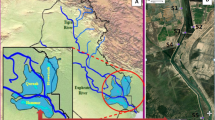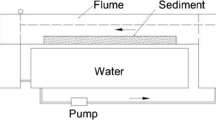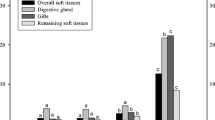Abstract
Ecotoxicological tests were conducted in the green-lipped mussel Perna viridis under laboratory conditions. Different rates of accumulation and depuration in soft tissues are found and this might be due to different mechanisms of metal binding and regulation. At the end of depuration, Cd levels in soft tissues of P. viridis were 10–30 times higher than before exposure, while Zn levels in soft tissues were almost similar to levels before exposure. These results indicate that P. viridis is a good biomonitoring organism for Cd but Zn levels might be actively regulated. It remains uncertain whether P. viridis is a good biomonitoring organism of environmental Zn contamination. However, the positive patterns, although different rates, of accumulation and depuration for Cd and Zn support the use of P. viridis as a biomonitoring agent for such metals.
Similar content being viewed by others
References
Amiard, J. C., C. Amiard-Triquet, B. Berthet & C. Metayer, 1986. Contribution to the ecotoxicological study of cadmium, lead, copper and zinc in the mussel Mytilus edulis I: Field study. Mar. Biol. 90: 425-431.
Boonchalermkit, S., S. Srilachai & P. Wongpan, 1998. Distribution of trace metals in green mussels (Perna viridis) from Thailand coastal waters. Paper presented at the 4th ASEAN-Canada CPMS-II Technical Conference Towards Sustainable Development and Integrated Management of the Marine Environment in ASEAN, 26-30th October, 1998, Langkawi, Malaysia (Abstract).
Carpene, E. & S. G. George, 1981. Absorption of cadmium by gills of Mytilus edulis (L.). Mol. Physiol. 1: 23-34.
Chan, H. M., 1989. Temporal and spatial fluctuations in trace metal concentrations in transplanted mussels in Hong Kong. Mar. Poll. Bull. 20: 82-86.
Chong, K. & W.-X. Wang, 2000. Assimilation of Cd, Cr and Zn by the green mussel Perna viridis and the Manila clam Ruditapes philippinarum. Envir. Toxicol. Chem. 19: 1660-1667.
Chong, K. & Wang, W.-X. Wang, 2001. Comparative studies on the biokinetics of Cd, Cr and Zn in the green mussel Perna viridis and the Manila clam Ruditapes philippinarum. Environ. Pollut. 115: 107-121.
Coombs, T. L. & P. J. Keller, 1982. Mytilus byssal thread as an environmental marker for metals. Aquat. Tox. 1: 291-300.
D'Silva, C. & T. W. Kureishy, 1978. Experimental studies on the accumulation of copper and zinc in the green mussel. Mar. Poll. Bull. 9: 187-190.
Da Ros, L., C. Nasci, I. Marigomez & M. Soto, 2000. Biomarkers and trace metals in the digestive gland of indigenous and transplanted mussels, Mytilus galloprovincialis, in Venice Lagoon, Italy. Mar. Envir. Res. 50: 417-423.
Dillon, T. M. & J. M. Neff, 1978. Mercury and the estuarine clam, Rangia cuneata Gray II. uptake, tissue distribution and depuration. Mar. Envir. Res. 1: 67-76.
Fan, W. & W.-X. Wang, 2001. Sediment geochemical controls on Cd, Cr, and Zn assimilation by the clam Ruditapes philippinarum. Envir. Toxicol. Chem. 20: 2309-2317.
Fowler, B. A., D. A. Wolfe & W. F. Kettler, 1975. Mercury and iron uptake by cytosomes in mantle epithelial cells of quahog clams (Mercenaria mercenaria) exposed to mercury. J. Fis. Res. Bd Can. 32: 1767-1775.
George, S. G. & T. L. Coombs, 1977. The effects of chelating agents on the uptake and accumulation of cadmium byMytilus edulis. Mar. Biol. 39: 261-268.
George, S. G., E. Carpene, T. L. Coombs, J. Overnell & A. Youngson, 1979. Characterisation of cadmium-binding proteins from mussel Mytilus edulis (L.), exposed to cadmium. Biochim. Biophys. Acta 580: 225-233.
Goldberg, E. D., 1975. The mussel watch - A first step in global marine monitoring. Mar. Poll. Bull. 6: 111.
Gundacker, C., 1999. Tissue-specific heavy metal (Cd, Pb, Cu, Zn) deposition in a natural population of the zebra mussel Dreissena polymorpha Pallas. Chemosphere 38: 3339-3356.
Hungspreugs, M., W. Utoomprurkporn, S. Dharmvanij & P. Sompongchaiyakul, 1989. The present status of the aquatic environment of Thailand. Mar. Poll. Bull. 20: 327-332.
Hutagalung, H. P., 1989. Mercury and cadmium content in green mussel, Mytilus viridis (L.) from onrush waters, Jakarta Bay. Bull. Environ. Contam.Toxicol. 42: 814-820.
Ikuta, K., 1986. Metal concentrations in byssuses and soft bodies of bivalves. Bull. Fac. Agric. Miyazaki Uni. 33: 255-264.
Ismail, A. & C. K. Yap, 2000. Byssus of green-lipped mussel Perna viridis (Linnaeus) as a potential biomarker for heavy metals. Paper presented at the Malaysian Science and Technology Congress 2000, Symposium B. 16th-18th, October, 2000, Hotel Casuarina, Ipoh.
Ismail, A., 1993. Heavy metals Cd, Cu, Pb and Zn in green mussel (Perna viridis L.) from the west coast of Peninsular Malaysia. IRPA / UKM Workshop and Seminar, Allson Kelana, Seremban Malaysia, 9-12 December, 1993.
Ismail, A., C. K. Yap, M. P. Zakaria, S. Tanabe, H. Takada & A. R. Ismail, 2000. Green-lipped mussel Perna viridis (L.) as a biomonitoring agent for heavy metals in the west coast of Peninsular Malaysia. In Shariff, M., F. M. Yusoff, N. Gopinath, H. M. Ibrahim & A. NikMustapha (eds), Towards Sustainable Management of the Straits of Malacca, Technical and Financial Options. Malacca Straits Research and Development Centre (MASDEC), University Putra Malaysia, Serdang, Malaysia: 553-559.
Kennedy, P. C., 1986. The use of molluscs for monitoring trace elements in the marine environment in New Zealand. 1. The contribution of ingested sediment to trace element concentrations in New Zealand molluscs. N. Z. J.mar. Freshwat. Res. 20: 627-640.
Klumpp, D. W. & C. Burdon-Jones, 1982. Investigations of the potential of bivalve molluscs as indicators of heavy metal levels in tropical marine waters. Aust. J mar. Freshwat. Res. 33: 285-300.
Lakshmanan, P. T. & P. N. K. Nambisan, 1989. Bioaccumulation and depuration of some trace metals in the Mussel Perna viridis (Linnaeus). Bull. Envir. Contam. Toxicol. 43: 131-138.
Liong, P. C., 1986. Heavy metals in shellfish from the northern part of Malacca Straits. In Chan, H. H., K. J. Ang, A. T. Law, M. I. Mohamed & I. Omar (eds), Development and Management of Tropical Living Aquatic Resources. Proceedings of an International Conference Held at UPM, Serdang, Selangor, Malaysia August 1983. Penerbit UPM, Serdang: 225-229.
Livingstone, D. R. & R. K. Pipe, 1992. Mussels and environmental contaminants: Molecular and cellular aspects. In Gosling, E. (ed.), The Mussel Mytilus: Ecology, Physiology, Genetics and Culture, Elseviers Science Publishers, Amsterdam: 425-464.
Lobel, P. B., 1987. Short-term and long-term uptake of zinc by the mussel,Mytilus edulis: a study in individual variability. Arch. Envir. Contam. Toxicol. 16: 723-732.
Luten, J. B., W. Bouquet, M. M. Burggraaf & J. Rus, 1986. Accumulation, elimination, and speciation of cadmium and zinc in mussel, Mytilus edulis, in Natural Environment. Bull. Envir. Contam. Toxicol. 37: 579-586.
Nicholson, S., 1999. Cardiac and lysosomal responses to periodic copper in the mussel Perna viridis (Bivalvia: Mytiloidae). Mar. Poll. Bull. 38: 1157-1162.
Phillips, D. J. H. & D. A. Segar, 1986. Use of bioindicator organism for monitoring contaminants: programme design imperatives. Mar. Poll. Bull. 17: 10-17.
Phillips, D. J. H. & P. S. Rainbow, 1993. Biomonitoring of Trace Aquatic Contaminants. Elsevier Science Publishers Limited, London. 371pp.
Phillips, D. J. H. & W. W. S. Yim, 1981. A comparative evaluation of oysters, mussels and sediments as indicators of trace metals in Hong Kong waters. Mar. Ecol. Prog. Ser. 6: 285-293.
Phillips, D. J. H., 1979. The rock oyster Saccostrea glomerata as an indicator of trace metals in Hong Kong. Mar. Biol. 52: 353-360.
Phillips, D. J. H., 1985. Organochlorines and trace metals in greenlipped mussels Perna viridis from Hong Kong Waters: a test of indicator ability. Mar. Ecol. Prog. Ser. 21: 251-258.
Pyatt, F. B., A. J. Pyatt & V. W. Pentreath, 1997. Distribution of metals and accumulation of lead by different tissues in the freshwater snail Lymnaea stagnalis (L.). Envir. Toxicol. Chem. 16: 1393-1395.
Rees, J. G., D. Setiapermana, V. A. Sharp, J. M. Weeks & T. M. Williams, 1999. Evaluation of the impacts of land-based contaminants on the benthic faunas of Jakarta Bay, Indonesia. Oceanol. Acta 22: 627-640.
Roesijadi, G. & W. E. Robinson, 1994. Metal regulation in aquatic animals: mechanisms of uptake, accumulation and release. In Malius, D. C. & G. K. Ostrander (eds), Aquatic Toxicity, Molecular, Biochemical and Cellular Perspectives. Boca Raton: Lewis Publishers: 387-420.
Roesijadi, G., 1980. The significance of low molecular weight, metallothionein-like protein in marine invertebrates: current status. Mar. Envir. Res. 4: 167-179.
Roesijadi, G., 1992. Metallothionein inmetal regulation and toxicity in aquatic animals. Aquat. Toxicol. 22: 81-113.
Senthilnathan, S., T. Balasubramanian & V. K. Venugopalan, 1998. Metal concentration in mussel Perna viridis (Bivalvia/Anisomyaria) and oyster Crassostrea madrasensis (Bivalvia/ Anisomyaria) from some parts in southeast coast of India. Ind. J. mar. Sci. 27: 206-210.
Sivalingam, P. M. & B. Bhaskaran, 1980. Experimental insight of trace metal environmental pollution problems in mussel farming. Aquaculture 20: 291-303.
Sivalingam, P. M., 1977. Aquaculture of the green mussel, Mytilus viridis Linnaues, in Malaysia. Aquaculture 11: 297-312.
Sukasem, P. & M. S. Tabucanon, 1993. Monitoring heavy metals in the Gulf of Thailand using Mussel Watch approach. Sci. Tot. Environ. 139/140: 297-305.
Taylor, D., 1983. The significance of the accumulation of cadmium by aquatic organisms. Ecotoxicol. Envir. Safety 7: 33-42.
Viarengo, A., M. Pertica, G. Mancinelli, R. Capelli & M. Orunesu, 1980. Effects of copper on the uptake of amino acids, on protein synthesis and on ATP content in different tissues of Mytilus galloprovincialis (Lam.). Mar. Envir. Res. 4: 145-152.
Viarengo, A., S. Palmero, G. Zanicchi, R. Capelli, R. Vaissiere & M. Orunesu, 1985. Role of metallothioneins in Cu and Cd accumulation and elimination in the gill and digestive gland cells of Mytilus galloprovincialis (Lam.). Mar. Envir. Res. 16: 23-36.
Webb, M., 1987. Toxicological significance of metallothionein. Experientia, Supplement 52: 109-134.
Widdows, J. & P. Donkin, 1992. Mussel and environmental contaminants: bioaccumulation and physiological aspects. In Gosling, E. (ed.), The Mussel Mytilus: Ecology, Physiology, Genetics and Culture. Elseviers Science Publishers, Amsterdam: 383-424.
Wong, C. K., R. Y. H. Cheung & M. H. Wong, 2000. Heavy metal concentrations in green-lipped mussels collected from Tolo Harbour and markets in Hong Kong and Shenzhen. Envir. Poll. 109: 165-171.
Yang, M. S. & J. A. J. Thompson, 1996. Binding of endogenous copper and zinc to cadmium-induced proteins in various tissues of Perna viridis. Arch. Envir. Contam. Toxicol. 30: 267-273.
Yap, C. K., A. Ismail, S. G. Tan & I. Abdul Rahim, 2003. Can the shell of the green-lipped mussel Perna viridis (Linnaeus) from the west coast of Peninsular Malaysia be a potential biomonitoring material for Cd, Pb and Zn? Estuar. coast. Sci. In press.
Author information
Authors and Affiliations
Rights and permissions
About this article
Cite this article
Yap, C.K., Ismail, A., Tan, S.G. et al. Accumulation, depuration and distribution of cadmium and zinc in the green-lipped mussel Perna viridis (Linnaeus) under laboratory conditions. Hydrobiologia 498, 151–160 (2003). https://doi.org/10.1023/A:1026221930811
Issue Date:
DOI: https://doi.org/10.1023/A:1026221930811




